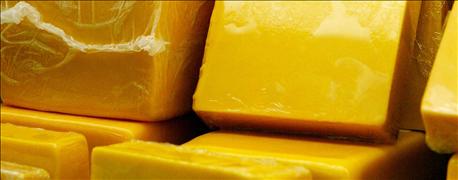
With growing stocks, butter makers are not seeking higher levels of cream to make butter, according to Bob Cropp, University of Wisconsin-Madison dairy economist. Available storage capacity for cheese plants in the Midwest is also becoming tight.
"A rather high level of milk production will likely stress milk plant capacity in both the Northeast and Midwest as we go through the spring flush period," Cropp notes.
The April Class III price will be near $13.65 compared to $15.81 last year and $24.31 two years ago, Cropp says.

Total cheese stocks were 10.8% higher and 13.5% higher than the five-year average for this date.
Other than butter, dairy product prices have shown little movement. On the CME both 40-pound cheddar blocks and barrels have been in the low $0.40s per pound most of April and will average around $0.43. Nonfat dry milk will average about $0.70 per pound. Dry whey will average about $0.25 per pound. Butter peaked at $2.17 per pound on April 11 but fell back to $2.04 by the end of the month.
"We can’t expect much upward price movement over the next month or two," Cropp says. "Milk production is increasing seasonally which means higher production of dairy products."
The latest dairy product report showed higher production than a year ago. Butter production was 5.8% higher (adjusted for leap year) than a year ago, and cheese 4.0% higher. Domestic sales of butter and cheese remain good, but exports continue to be weak. While February butter exports were 61% higher than a year ago, they were still a fraction of the level of exports in 2014. Cheese exports were 17% below a year ago, the 17th straight month the volume of exports have lagged a year earlier. Dry whey exports were 5% lower.
"Higher butter and cheese prices than world prices continue to attract imports," Cropp explains. "While January –February imports of butter under quota were 13.5% lower than a year ago, high tier imports were 266.9% higher. Quota cheese imports were 48.4% higher and high tier 43.4% higher."
Cropp says growing stocks will keep downward pressure on dairy product prices.
"Compared to a year ago, butter stocks were 31.5% higher and 26.2% higher than the five-year average for this date," he says.
Total cheese stocks were 10.8% higher and 13.5% higher than the five-year average for this date. Relatively strong exports resulted in nonfat dry milk stocks to be 10.5% lower, but still 12.5% higher than the five-year average for this date. Dry whey stocks were 20.1% higher.
While butter and cheese sales are expected to remain good, exports are not expected to show much improvement until late in the year or early next year. World dairy product prices, with the exception of nonfat dry milk/skim milk powder, remain depressed and well below U.S. prices.
"World milk production continues to run well above a year ago primarily due to higher production in the EU countries," Cropp says. And the two largest world importers of dairy products, China and Russia, remain rather inactive.
"Looking ahead, most price forecasters show a slow increase in milk prices as we move through the year but staying relatively low," according to Cropp.
Class III futures don’t reach $14 until July and $15 until September and peak in November in the low $15s. USDA now forecasts the Class III price for the year to only average between $13.65 to $14.15, the Class IV price to average between $12.90 and $13.50 and the U.S. all-milk price is expected to average between $15and $15.50.
"If milk production continues to show rather strong increases and exports do not improve, these prices are quite likely," Cropp contends. "But, there is still a good possibility prices could do somewhat better than this for the second half of the year."
About the Author(s)
You May Also Like






